LG Beowulf – the highest yielding wheat on the 2024-25 AHDB Recommended List
Ron Granger shares his views on what the variety offers and where it fits on farm:

Arable Technical Manager
When breeders cross two varieties, we know what we want to accomplish with regards to the complimentary attributes both parent varieties offer – genetically and agronomically – in the progeny.
LG Beowulf reflects this approach, as a cross between two very successful commercial varieties; (Costello x Gleam). Recently, we have seen several very high yielding wheats added to the RL, but unfortunately, although gaining commercial market share, they have not offered the all-round desirable agronomic package that many growers wish for in a perfect world.
LG Beowulf bucks the trend, offering the highest UK treated yield potential sitting at 106.2%, and one of the best agronomic packages available, combined with great flexibility within the rotation – it’s a fantastic package!
High yields are important for maximising profit, but more than this, a grower needs to know that these yields will be delivered consistently every season; and this is exactly what LG Beowulf does.
 It performs extremely well both as a first wheat and in the more testing second wheat situation and is suitable for all soil types. However, LG Beowulf should be grown on more moisture retentive soils to achieve maximum yield potential, as there are better variety ideotypes for the more testing, lighter, drought prone soil situations.
It performs extremely well both as a first wheat and in the more testing second wheat situation and is suitable for all soil types. However, LG Beowulf should be grown on more moisture retentive soils to achieve maximum yield potential, as there are better variety ideotypes for the more testing, lighter, drought prone soil situations.
LG Beowulf offers a very good disease resistance profile, especially for the key disease challenges of yellow rust (9) and Septoria tritici (6.7). The variety also delivers a very high untreated yield (91%); a consequence of its superb disease resistance in combination with its straw strength. LG Beowulf offers very good straw strength – combining a rating of 8 untreated, with an 8 rating with PGR treatments applied. Offering Orange Wheat Blossom Midge resistance is an important benefit, especially for growers in the more drought prone regions of the southeast. It’s a genetic IPM offering that should not be underestimated.
LG Beowulf can be drilled early and onwards through into the very late drilling slot, if the season dictates, giving growers a security and flexibility of drilling date, that not all varieties exhibit. The variety does have a slightly later maturity, but widening the harvest date is useful as an insurance against erratic weather patterns. Spread your risk on farm by having early maturing varieties alongside later maturing ones.
LG Beowulf has the benefit of a high specific weight combined with a high Hagberg. A high specific weight is one of the best characteristics to ensure high yield potential is maintained in erratic, seasonal weather conditions.
“There is no such thing as a perfect variety, however, LG Beowulf comes close!”
It offers a comprehensive agronomy package along with very high yield potential in the hard feed wheat sector; desirable characteristics both on-farm and for the market.
Click here to download the LG Beowulf Technical Sheet
Perfect Fit for Regen SystemA large estate in the northeast of England, has turned to wheat variety LG Typhoon as part of its drive to build a more sustainable regenerative cropping system.
The in-house farming operation of County Durham-based Raby Estates, began conversion to direct drilling in 2018 and is striving to reduce the use of artificial inputs where possible, without compromising on the quality and quantity of crops produced.
“We’re trying to move away from growing high input varieties, so are primarily looking for those that offer a robust disease package, good standing power and suitability for our direct drilling system,” according to farm manager Philip Vickers.
“Direct drilling in northern England is not something you want to be doing into November, so I also look for varieties that suit the early drilling slot. From what we’ve seen so far, LG Typhoon seems to fit our requirements well.”
Strong performance
In 2022, the farm grew around 32 ha (80 acres) of LG Typhoon, alongside several other varieties, but Mr Vickers has been so impressed with its agronomics, ease of management and yield performance, that he has increased this to 100 ha for 2023/24.
The LG Typhoon averaged an excellent 9.4-9.6 t/ha.
“Agronomy-wise, LG Typhoon was problem-free. It established quickly in the autumn, got away well in the spring, and was relatively early to harvest, tight behind Graham.”
Robust disease profile
Strong Septoria resistance is a must-have for all winter wheat varieties grown on the farm, as the disease remains the number one yield-robber in high pressure seasons.
With a Septoria rating of 7.2, backed up by a combination of genetics that are different to those in other RL varieties, LG Typhoon has a distinct advantage over others.
Perfect fit for regen systems
LG Typhoon offers attributes that make it ideally suited to strip tillage/ direct drilling, regenerative crop establishment systems, that often feature wider rows.
- –> High yielding, consistent & resilient variety, that delivers across seasons & rotations
–> A prostrate growth habit with a slower plant development through the autumn & winter months
–> High tillering variety that utilises the space from wider rows often associated with direct-drilling
–> Very good disease resistance profile reflected in its high untreated yield
–> Exceptional disease ratings for yellow rust (9) & Septoria (7.2)
–> Good standing
–> OWBM resistance
–> Excellent performance as a second wheat -
-
LG Typhoon is a high yielding, consistent & resilient variety, that delivers across seasons & rotations!
Hard feed wheats account for more than half of the UK winter wheat market, and will undoubtedly feature heavily again in many cropping plans this autumn, as growers look to bounce back from the rain-hit 2023/24 season.
Winter wheat remains the highest gross margin crop on most arable farms, with yield still regarded as being ‘king’ for maximising returns. But, achieving high yields when faced with more extreme and unpredictable weather, alongside the many other agronomic challenges, requires varieties with strong agronomics and proven, consistent, performance across multiple seasons, says Limagrain UK.
“Farmers are increasingly looking for security on-farm,” says the firm’s arable technical manager, Ron Granger. “You need a variety that delivers the right agronomics, as well as high yield.”
It is something Limagrain UK is providing, with a range of exciting new hard wheat varieties coming through its UK breeding programme, including LG Typhoon (launched two years ago), newcomer this year, LG Beowulf, and 2024 RL Candidate variety, LG Rebellion.
Genetic gains
These varieties, and two others currently in National List trials that will hopefully progress as Candidates for 2025, are the latest results of several years of ongoing breeding development, says Limagrain UK wheat breeder, Phil Tailby.
“When the UK market started shifting towards hard wheats several years ago, it took a few years for breeding programmes to adapt and new hard wheat varieties to come through. But, by using powerful breeding tools, such as marker-assisted and genomic selection, we have been able to increase selection intensity, improve selection accuracy, and reduce the time needed to develop the next generation.
“This ultimately drives faster varietal improvements, delivering the traits that growers want and need in modern wheat varieties.”
LG Typhoon for example, has an excellent disease resistance profile, especially for yellow rust (rated 9) and Septoria tritici (7.2), plus it has orange wheat blossom midge (OWBM) resistance, good specific weight, and a slow, prostrate growth habit that suits both early sowing and wide-row, direct drilling situations.
“It joined the Recommended List in 2022 with a range of agronomic attributes that are beneficial to farmers,” says Mr Granger. “These characteristics have seen it deliver excellent consistency across different seasons and regions, and suitability for the on-farm placement we have advised.”
LG Typhoon’s suitability for early drilling could be particularly pertinent this year, given the likely desire by growers to avoid a repeat of last autumn, when many drilling plans were halted by heavy rain during October onwards, he notes.
Newcomer LG Beowulf takes genetic gains on a stage further, building on its strong Costello x Gleam parentage, Mr Granger continues.
It delivers a range of desirable agronomic characteristics that make it the highest yielding variety on the RL, with proven performance across a range of situations, soil types and regions, including the North. LG Beowulf has a strong disease profile, rated 9 for yellow rust, and 6.7 for Septoria tritici, stiff straw, strong tillering, OWBM resistance, and good grain quality, particularly specific weight.
LG Beowulf has also inherited Gleam’s robustness and ability to be sown into a wide range of drilling dates and still deliver on yield, he adds.
RL Candidate variety for 2024, LG Rebellion, offers similarly impressive performance, capitalising on its KWS Extase parentage to give very high untreated yields, and an excellent disease resistance profile (notably against yellow rust and Septoria), with the additional genetics of Pch1 eyespot resistance.
LG Rebellion is also earlier maturing than KWS Extase and, unusually for a hard Group 4 variety, it has ukp export potential thanks to its excellent grain quality.
“It ticks many different boxes and gives growers the option of going for something that’s a bit different to other hard feed wheats on the market,” says Mr Granger.
Market insight

David Brown
Hard Group 4 wheats are estimated to account for around 54% of the UK wheat area, based on seed sales and farm-saved seed data, according to Openfield’s David Brown, who believes it will remain a key sector for UK growers.
While many hard Group 4 wheats go into animal feed production, in some years, there is a potential milling premium available – typically worth £2-5/t over the feed price – for crops of sufficient quality to be blended into the grist with other high-protein grade varieties, he says.
Milling demand and specifications for hard wheats do vary season-by-season, but users typically require 10.7% protein, 180 Hagberg, and 74 kg/hl specific weight, although these thresholds can be down to 10.2%, 130 and 74 kg/hl, depending on the season and overall crop quality, he says.
“Milling demand and hard wheat specifications are usually made in September, once millers know the quality profile for EU and UK crops.
“The UK is currently trading at import parity for full-spec Group 1 milling wheat and if millers continue to import, we could see more opportunity for UK hard wheat going into the grist.”
Much will depend on the size and quality of crops in the UK and elsewhere, which at the time of writing, remains uncertain given the challenging weather across much of Europe, Mr Brown says.
“With a reduced wheat area in the ground for this harvest – estimated at around 1.4 million ha – a much lower UK crop is widely anticipated, although estimates vary as to how much it will be down. The crop in the ground to be harvested in August 2024 could be between 9 and 11 million tonnes, which is comparable with 2020, and to put this into context, crop 2022 was 15.5 million tonnes and crop 2023 is circa 14 million tonnes,” he says.
Potentially, that could help support markets, but with a lower crop, the UK will be more reliant on imports, which is therefore likely to cap domestic prices, he adds.
“The UK will continue to follow global markets. These did move slightly higher during May, but all eyes remain fixed on the new crop and how that will be impacted by the weather around the world, and other events (e.g. the wars in Ukraine and the Middle East), over the coming months.”
New LG hard wheats: key attributes
|
LG Rebellion (Candidate 2024) |
||
|
Agronomic characteristics for securing consistent yield performance over multiple seasons and regions on farm |
The highest yielding variety, offering high yield potential in all regions, including the North |
High yield potential combined with the desirable agronomic characteristics of KWS Extase |
|
Prostrate growth with high tillering capacity suits early drilling, direct-drill regen situations |
Wide drilling window and suitability for a range of situations (1st vs 2nd wheat), and differing soil types |
Agronomics suit the main October and later drilling dates on farm. Very high untreated yield (97) reflects strong all-round disease profile |
|
Excellent disease resistance (especially Septoria and yellow rust) – high untreated yield, OWBM resistance |
Excellent disease profile (especially yellow rust and Septoria), OWBM resistance, and tall, stiff straw |
Excellent disease resistance profile – similar to KWS Extase, plus Pch1 eyespot resistance |
|
+2 maturity versus Skyfall |
Similar maturity to LG Typhoon |
Earlier maturing (-2 vs Skyfall) |
|
Good specific weight |
Excellent grain quality, combining a high Hagberg and specific weight |
Excellent grain quality, plus ukp export potential |
From early to late drilling, ploughed land to min-tilled, and high to low soil fertility, Fife farmer & contractor, Zander Hughes, faces almost every possible cropping scenario across the 320 ha (800 acres) he farms for a range of clients.

Zander Hughes
Such variability represents a stern test for any variety, but for Mr Hughes, LG Skyscraper continues to be the stand-out performer in terms of its consistent yield and quality across multiple seasons, and flexibility to go into a range of drilling situations.
Having grown LG Skyscraper since its launch five years ago, the variety once again accounts for his entire winter wheat area, with around 130 ha in the ground for harvest 2024, up from 81 ha last season, due to rotational shifts and a slight reduction in spring barley area. Most is sown as a first wheat after potatoes, vegetables, grass, or spring barley.
“We’ve never had any problems with LG Skyscraper; we really like it as a variety. To this day, LG Skyscraper remains the variety that produced the biggest yield I’ve ever grown, at 14.5 t/ha in the year we first tried it.”
Although last year’s crop did not quite reach that level, he says it still performed really well, averaging 10.5-10.75 t/ha across the whole wheat area, with big, bold grains, good quality, and plenty of straw that stood well.
That performance came despite relatively high disease pressure last season, and challenging conditions that meant the first T0 fungicide, plus growth regulator, could not be applied, he notes.
“That did put slightly more pressure on the T1 and T2 growth regulators in high fertility situations, but despite this, crops generally still stood really well.”
Looking good in a tough year
As for this year’s crop, Mr Hughes says the vast majority was drilled into good conditions, despite tricky autumn weather that stretched the drilling window from 1 September to mid-November. Some fields were ploughed, while others were min-tilled, although decisions are very much taken on a field-by-field basis, depending on soil conditions and previous cropping, he notes.
LG Skyscraper has a fairly vigorous growth habit once it germinates, so Mr Hughes has no fear of sowing it later, as he might with some other varieties.
As always, seed rates were adjusted according to drilling date and conditions, ranging from 375 seeds/m2 at the lowest, up to 525 seeds/m2 in the most challenging situations last autumn.
“At the moment, there aren’t really any obvious differences between the early and late-sown crops. We’ve found that standing water on some fields – which is a new thing for us this year – has had more of an effect than drilling date.”
With most crops around growth stage 31 (T1) at the time of writing, Mr Hughes says generally the LG Skyscraper all looks well, with no obvious issues, despite ideal conditions for Septoria and yellow rust development over much of the season so far.
Given higher disease risk, robust SDHI and triazole-based T1 and T2 fungicides will be used to protect the important yield-building leaves through the remainder of the growing season, and maximise crop potential. This will build on the prothioconazole-based T0 applied earlier this spring, accompanied by trinexapac-ethyl and chlormequat growth regulators, and trace elements.
“Growth stages are slightly all over the place at the moment, even within the same field, so we’re hoping the T0 growth regulator will reduce the apical dominance of the main stems a bit, as they’re a lot further on than the tillers at this stage. We’ll also apply another growth regulator at T1, although decisions are taken on a field-by-field basis.”
Nitrogen is usually applied in three doses, but this year Mr Hughes has favoured more of a “little and often” approach, based on four applications of granular fertiliser, roughly in a 30-40-20-10% split, to reduce any potential risks of field losses due to the weather. Total application generally averages around 210 kg/ha, although this ranges from 180 kg/ha to 240 kg/ha depending on soil levels and crop potential.
Sticking with LG Skyscraper
Looking ahead to next season, Mr Hughes plans to continue growing LG Skyscraper, although is also going to try Limagrain UK’s new hard Group 4 variety, LG Beowulf, which joined the AHDB Recommended List this year as the highest yielding winter wheat.
LG Skyscraper is just one of 16 varieties featuring in a Limagrain UK variety demonstration that Mr Hughes is hosting for the first time this season.
“The demonstration is being held on one of our contract farms that hasn’t grown wheat for around 15 years. My initial plan was to go with LG Skyscraper on this farm, because it’s one we like and has done well for us, but there was some debate as to what variety would best suit the farm, hence hosting the trial here.”
As well as a range of Limagrain UK and competitor varieties, the demonstration is also looking at the impact of different seed rates on four Limagrain wheats, sown at half, three-quarters, 100%, and 125% of the standard seed rate.
LG Skyscraper
–> Soft Group 4 wheat
–> First listed on the RL in 2019
–> OWBM resistance
–> Good yellow rust resistance (7)/ Septoria requires monitoring
–> Consistent yield and quality performance over multiple years
–> Flexibility for a range of rotational positions (1st or 2nd wheat), sowing dates, and soil types
–> Good grain quality – specific weight (77.1 kg/hl)
–> End market flexibility – feed/ distilling/ biscuit grists
LG’s Summer Demo DaysLG has a range of summer open days across the UK, to present their demo trials, alongside Limagrain’s technical experts who will be providing all the latest information on new & existing varieties.
As well as the LG experts, each event will feature industry experts from within the agricultural sector, providing technical information on an array of topics such as fertiliser & micronutrients, agrochemicals, SFI’s and more. On top of this, we will again be running the Moisture Meter Clinic, which has been a farmer favourite in past years.
LG’s Summer Demos will have a wide assortment of winter wheat varieties to show, including Limagrain’s No.1 highest yielding variety; LG Beowulf, and a taste of Limagrain’s up and coming RL Candidates and NL2 offerings.
Alongside this, they will also be displaying commercial competitor varieties, with both untreated and treated plots.
Rothwell and Woolpit will be showing all varieties in the Limagrain winter barley portfolio, including the 2 highest yielding; LG Caravelle & LG Capitol, plus exciting new BYDV tolerant RL Candidate, LG Carpenter.
Register now…
—-> Tues 9th July – Rothwell, Lincolnshire
—-> Weds 17th July – Perth, Perthshire
BASIS/NRoSO points will be available for each Demo Day.
If you are thinking of growing an LG variety, have an interest in learning more, or have any questions for our experts, Register Now for one of our Demo Days.
Highest yielding Recommended varieties on show at CerealsPlant breeders Limagrain UK will showcase their impressive portfolio of varieties across crop sectors at Cereals 2024.
After several years absence from Cereals, the breeders have returned to the Event on the back of their resounding success on the 2024/2025 AHDB Recommended List.
“Producing the highest yielding varieties, backed up with desirable agronomic characteristics is an exceptional achievement for any breeder. What’s more, these varieties have proven to be robust and consistent performers across seasons and regions,” explains Ron Granger, Limagrain’s arable technical manager.
 Visit stand 606 to find out more about the highest yielding winter wheat LG Beowulf, LG Caravelle the highest yielding 2-row winter barley and the highest gross output oilseed rape varieties LG Armada, LG Adeline and LG Academic.
Visit stand 606 to find out more about the highest yielding winter wheat LG Beowulf, LG Caravelle the highest yielding 2-row winter barley and the highest gross output oilseed rape varieties LG Armada, LG Adeline and LG Academic.
There will also be experts on hand to discuss Limagrain’s very diverse portfolio, including maize, forage crops and SFI options as well as an opportunity to enter a prize draw to win free seed.
“We are here to listen and share our expertise on how to get the very best out of Limagrain genetics, and the Cereals Event gives us the opportunity to do this directly with the farming community we serve,” he says.
Visit LG on stand 606, buy tickets here
Crusoe tops YEN wheat quality awardsLimagrain UK’s benchmark milling wheat variety, Crusoe, has claimed the top three positions in the Yield Enhancement Network (YEN) Milling Wheat Quality awards.

Richard Budd
It is welcome recognition for the Group 1 variety that, in the 12 years since joining the AHDB Recommended List, has established itself as a firm favourite amongst growers and millers due to its consistent yield and quality performance, across a range of very different seasons.
First-place in the 2023 YEN award went to Richard Budd, of Stevens Farm (Hawkhurst Ltd), who grows around 220 ha of Crusoe across 1,400 ha in Kent and Sussex. The farm’s focus is on growing quality Group 1 and 2 wheats, to supply local flour mills and occasional export markets, and he values the reliability that Crusoe offers.
“We’ve only been growing Crusoe for three or four years, as previously we had been doing really well with KWS Zyatt and Skyfall. But, they both became uneconomic to grow due to their disease profiles, so last year we made the decision to go completely with Crusoe, which now accounts for one-third of our wheat area, alongside KWS Extase and Mayflower for the remainder.
“So far, Crusoe has served us well. It’s yielded well, is relatively clean and easy to manage, stands well and has a good specific weight, protein, and Hagberg. It’s a solid, stable variety.”
With milling wheat premiums touching £72/t over feed at the time of writing, and predicted to stay firm for the foreseeable future given tight European supplies, Mr Budd is cautiously optimistic for the 2024 harvest, despite a challenging start to the season.
“Admittedly, I’d like an extra 5% yield, but I understand UK flour millers may be less keen on that due to the potential protein dilution. We do need some new genetics in the Group 1 sector, but at the moment, Crusoe is our default variety.”
Hitting protein spec

Chris Eglington
Norfolk Crusoe grower, Chris Eglington, won gold in the 2022 YEN Milling Wheat Quality awards, and claimed silver with the variety in 2023, recording the highest grain protein of 13.7% and one of the highest specific weights at 78.2 kg/hl for his 10.5 t/ha crop.
He too values Crusoe’s performance in what was a tricky 2023 season.
“Yes, it’s been around a while now, but it’s great to have a variety that we know how to manage and know will perform well.”
Last year’s crop followed oilseed rape, with land cultivated using an 8-metre Väderstad Carrier prior to drilling on 14 September, then rolled and a residual herbicide applied.
Variable rate potash, lime (where required) and nitrogen applications are used across the farm, and he has worked closely with grain buyer Camgrain, and in the past with Sainsbury’s, to optimise nitrogen inputs and protein.
Mr Eglington recognises nitrogen management could be more challenging this spring, given the impact of the exceptionally wet autumn and winter on residual soil levels.
“We’re already towards the top of what we can apply in terms of nitrogen, so I don’t think our programme will change drastically. We’ve always found the highest yields come in years when we’ve managed to get nitrogen on early, and fortunately we did manage to apply the first lot of nitrogen during a narrow window in early February, and might apply some more in early March, depending on how the crop looks.”
Typically, first wheats receive a total of 280 kg N/ha, applied as four splits of solid granular fertiliser, sometimes supplemented with a small amount of liquid urea towards the end of the season (June), to help build grain protein if required.
Regular tissue testing is also used to adjust the nitrogen programme according to crop need.
Mr Budd also recognises the importance of early nitrogen to support tillering and biomass accumulation, and has previously seen good results from applying two large splits of 80-90 kg N/ha when conditions allow in February, and again in late March/ early April. Tissue testing is then used to refine later applications according to crop requirements.
Staying disease free
Mr Budd’s nutrition strategy is supported with a robust, preventative fungicide programme, tailored to disease pressure around each spray timing and varietal resistance. His aim is to keep upper and lower leaves free from disease as long as possible, rather than relying solely on the flag and leaf two to build yield.
“With our direct/ strip-till system, we find that if we can keep leaves 3, 4, and even 5 and 6 relatively clean throughout the year, they are still contributing quite a lot to final yield, right up to cheesy ripe stage.
“That said, we’re not applying maximum rate fungicides all of the time; decisions are guided by what’s there at the time, and varietal choice.
“I like Crusoe; it is a relatively easy, clean variety, with good Septoria scores, and yellow rust is non-existent really.”
Late-season brown rust is something to watch out for in some years, but even that is relatively easy to control, with a good range of chemistry available, he notes. “As an industry, we need to be looking more at genetics rather than a can.”
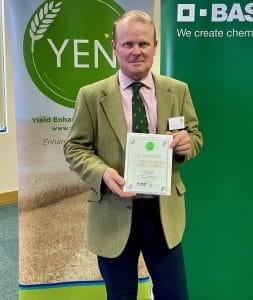
Edward Vipond
Confidence to invest
Having confidence in a variety’s ability to regularly achieve milling specification is vital for Suffolk farmer Edward Vipond, who says Crusoe has become the “go-to” variety in the first wheat slot at the 1,400 ha Troston Farms, near Bury St Edmunds.
The farm grew 160 ha of Crusoe last season, and has increased this to 224 ha for 2024.
“When you’re spending a lot of money on fertiliser to obtain a milling premium, applying 270-280 kg N/ha for example…
“…you need confidence that the crop will deliver in terms of protein, and Crusoe does that. Protein is as much down to the variety’s genetics as how you manage it.”
He also notes that Crusoe seems more consistent than other milling wheats grown on the farm. “For us, even at yields of 10.5 t/ha, it will still regularly obtain 13.3-13.5% protein.”
Last season’s wet summer did pose challenges for protecting quality, with milling wheats prioritised for harvesting slightly earlier than they might have been in a drier year, Mr Vipond says.
This did raise a few issues with thrashing on the combine, resulting in some unthrashed tips in the grain sample, but he insists the benefits of hitting milling specification far outweighed any drawbacks.
“There aren’t that many other competitors in the Group 1 list at the moment. There are one or two coming in, but they’re yet to be proven and have got to do something special to knock Crusoe off. Crusoe suits our land and it delivers.”
Mr Vipond says flexibility and attention to detail are key to getting the best from any crop, particularly in terms of drilling date, seed rates, nutrition and other inputs. He generally drills Crusoe in early October to reduce BYDV risk, opting for seed rates of around 325-350 seeds/m2.
There is no fixed cultivation or drilling strategy though, instead the farm opts for whichever equipment suits conditions at the time. Some fields after potatoes or onions, for example, are established with a plough and combination drill, while others may receive a non-inversion deep tine (e.g. Sumo Quatro) before drilling with a disc or tine machine. “Every season is different, so we do what is required.
“Yield is still king, and if you can get decent yields of good spec milling wheat at a premium of £50-60/t, the return is still there. With the results we had from Crusoe last year, what’s not to like?”
Summary of the top three YEN wheat samples, all Crusoe
|
|
Gold (Richard Budd) |
Silver (Chris Eglington) |
Bronze (Edward Vipond) |
|
Yield (t/ha) |
11.9 |
10.5 |
10.4 |
|
Moisture (%) |
15 |
14.4 |
14.1 |
|
Protein (%) |
13.6 |
13.7 |
13.3 |
|
Specific weight (kg/hl) |
76.2 |
78.2 |
76.9 |
|
Hagberg (seconds) |
334 |
368 |
349 |
LG Skyscraper delivers gold for Lincs grower
It’s second time lucky for Lincolnshire grower Mark Stubbs as he takes top prize in the ADAS Yield Enhancement Network Cereals competition for 2023, with his crop of LG Skyscraper winter wheat yielding an outstanding 16.6t/ha. His last win was in 2019, with a crop of KWS Siskin that yielded 16.3t/ha.
Mr Stubbs puts his success down to an attention to detail encompassing delayed drilling, widespread use of farmyard manure and a move away from ploughing.
Farming 688 ha’s across two sites, on the Wolds and along the coast, wheat is the mainstay of the rotation which also includes oilseed rape and spring barley, for A&C Stubbs & Sons.
The block of 120 ha’s on the Wolds at Marsh Chapel is a heavy, clay site and Mr Stubbs has been growing LG Skyscraper here for several years.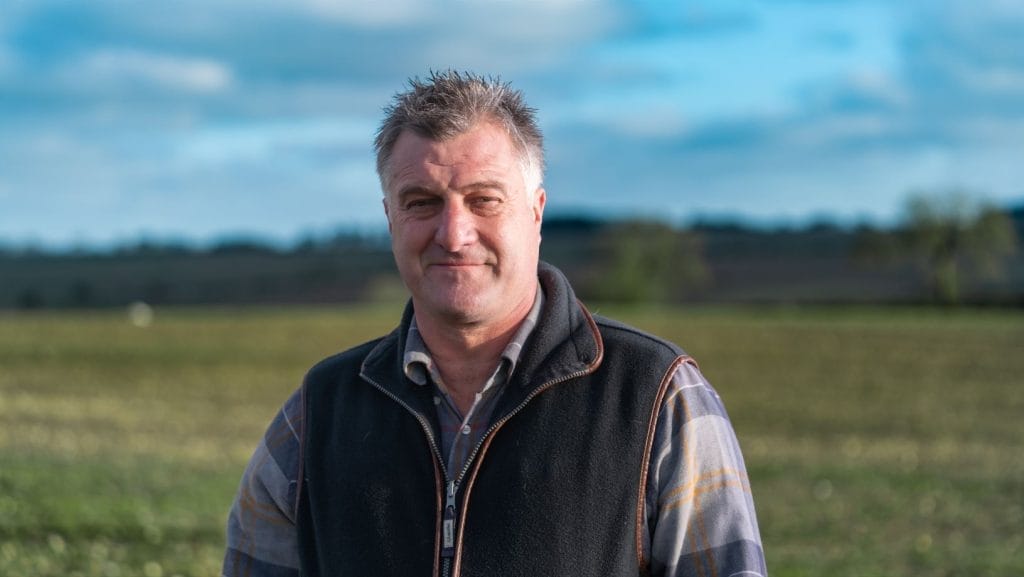
He has always been pleased with the variety’s yields, which have averaged 10.5t/ha over this time. Grain quality has also been consistently good, and while this is not crucial to him from an end market point of view, specific weight is a priority with last year’s crop delivering a very acceptable spec weight of 80kg/hl.
LG Skyscraper joined the AHDB Recommended List in 2019, as the highest yielding wheat and maintained this pole position in 2020. Since then, it has remained a firm favourite on farm for its consistent high yielding performance across seasons, strong agronomics and suitability for later drilling for black-grass control.
Mr Stubbs’ attention to detail and planning before the season begins is a key part of his approach.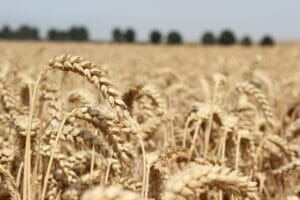
This starts with variety choice; he grows seed crops of new varieties, so is in a good position to see what varieties do well in the colder, exposed Wold conditions, or in fields along the coast.
The 2023 YEN winning wheat crop followed an oilseed rape crop that was allowed to green-up for as long as possible acting as a catch crop, before cultivating with a tine disc cultivator and packer, followed by a shallow disc cultivator.
Wheats are generally drilled around the last week of October; however, last year it was very wet, so he waited a week, drilling the LG Skyscraper on 11 November, at a rate of 250kg/ha aiming for a plant population of 275 plants/m2 in the spring.
His aim – given the blackgrass legacy – is to produce a thick, competitive crop which has immediate access to nutrients, so that it can grow away strongly.
“LG Skyscraper has a fairly vigorous growth habit once it germinates, so I don’t worry about sowing it later, as I might with some other varieties,” he says.
After several years of growing wheats, and particularly LG Skyscraper, Mr Stubbs recognises the importance of optimising crop nutrition to achieve the high yields he is pushing for.
He says manures, which are applied to stubbles and then incorporated within six hours, have seen the soil organic matter rise from an index of 2-10 despite the highly, acidic calciferous soils.
“We find that the nutrition contained in the manures kicks in early on, giving the crop a good start.”
For the YEN crop, liquid Nitrogen (225N,10%S) was applied in three splits, four weeks apart, and on average received 210kgN/ha, excluding the manure.
He favours a “little and often” approach, and in-season crop monitoring to fine-tune requirements. “We soil test and use the Yara N-tester to gauge how well the plant is doing and to address any shortfalls.”
A standard four spray programme was used for the LG Skyscraper. “ The variety has a weaker rating for Septoria (4.9), so it is important to tackle this early which means we are not chasing disease through this season, and in doing so we have never had too much of a problem,” he says.
“I don’t cut corners in terms of timing but will alter products according to the weather and disease pressure at the time.”
“Despite being slightly taller-strawed, lodging in LG Skyscraper has never been an issue even on the more fertile Wold soils, but we use PGR’s as and when needed, to support the crop we have in the ground.”
“As last year’s crop was grown on the March site with heavier soils, crop emergence and growth were slower, and coupled with late drilling, the crop didn’t reach a leggy stage, so a robust T1 was used which proved sufficient to regulate the crop.”
He explains that a T0 was applied but with the key aim of manipulating the plant to ensure it was strong and healthy, and a bio stimulant was applied to boost the plant’s defence mechanism to fight any initial infections.
Harvest took place on August 10 – which Mr Stubbs points out was early for a late-drilled crop. “It literally turned overnight, it wasn’t ripe when we checked it two days before, so I think we caught it just in time.”
His YEN report is useful and highlights where attention to detail is needed.
“We’re using YEN where we can to improve the farm,” Mr Stubbs says.
YEN Success
- Area – 3.2 ha (8 acres)
- Variety – LG Skyscraper
- Yield – 16.6t/ha
- Specific weight – 80 kg/hl
A&C Stubbs & Sons, Manor Farm, Calcethorpe
- 695ha of owned, tenanted and farm business tenancy (FBT) land
- Winter wheat, winter oilseed rape, spring barley
- Haulage business
LG Skyscraper Fungicide Programme
- T0 – Zonor + Scyon
- T1 – Medax Max + Silvron Xpro + Firefly 155 + Starane Hi -Load + Ally max
- T2 – Revystar XE + Tubosan
- T3 – Deacon + Soratel + Kendo
Plant breeder Limagrain’s winter wheat LG Beowulf and 2-row winter barley LG Caravelle, are the highest yielding varieties to join the 2024/25 AHDB Recommended List.
LG Armada also takes lead position as the highest yielding oilseed rape variety on the Recommended List for the UK, whilst LG Adeline takes pole position for oilseed rape in the North.
In addition, high yielding maize variety Saxon tops the 2024 BSPB Forage Maize Descriptive List for ME yield (‘000s MJ/ha).
This means that LG now offer the highest yielding varieties in; winter wheat, 2 row winter barley, OSR and maize*.

“This is an exceptional achievement for any breeder,” explains Ron Granger, Limagrain’s arable technical manager.
“Last year saw our winter wheat and winter barley varieties take pole positions across the RL. We have built on this success for a second year running, producing higher yielding varieties, backed up with desirable agronomic characteristics, securing high yield performance on farm. What’s more, these varieties have proven to be robust and consistent performers across seasons and regions.”
Highest yielding winter wheat
Group 4 hard wheat LG Beowulf yields 106% across the UK and shows the same consistency of performance across all regions: east (106%), west (106%) and the north (107%) – an outstanding achievement for any variety.
 LG Beowulf has produced these exceptionally high yields consistently in National List and RL trials over regions and seasons, in both the unusually dry summer of 2022 as well as the exceptionally wet summer of 2023. Alongside these yields, it offers a good grain quality, with a spec weight of 78.3 kg/hl.
LG Beowulf has produced these exceptionally high yields consistently in National List and RL trials over regions and seasons, in both the unusually dry summer of 2022 as well as the exceptionally wet summer of 2023. Alongside these yields, it offers a good grain quality, with a spec weight of 78.3 kg/hl.
“LG Beowulf is much like LG Skyscraper; it performs wherever you grow it,” he says. “It can be drilled early or late – providing growers with a wide drilling window, as a first or second wheat, on light or heavy land, and there are very few varieties that meet this criterion,” he says.
LG Beowulf yields are backed up by a set of strong agronomic characteristics, offering an excellent disease resistance profile with ratings of 9 for yellow rust, 6.7 for septoria, as well as orange wheat blossom midge (OWBM) resistance.
It has very stiff straw and is rated 8 for standing in untreated and PGR treated trials, which strongly contributes to its reliability on farm.
“In summary, LG Beowulf is a very high yielding, robust and versatile variety that comes at a time when growers are looking more than ever to maximise output, in order to maintain profit in times of increasing costs,” says Mr Granger.
Highest yielding winter barley
LG Caravelle is the highest yielding two-row winter barley for the second year running, since joining the Recommended List in 2023.
“Offering UK yields of 105.6%, LG Caravelle continues to dispel any misconception that two row barleys are lower yielding than hybrids. The variety certainly competes with the best yielding hybrid barleys, especially in the east,” says Mr Granger. “LG Caravelle is competitive in a black-grass situation, another characteristic that is normally associated with hybrids.” 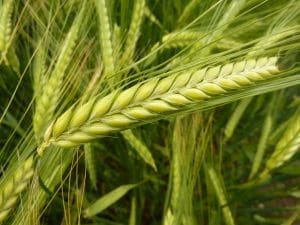
“LG Caravelle’s high yields are backed up by an excellent disease profile, reflected in its superb untreated performance, it is early maturing with stiff straw and good brackling resistance.”
“LG Caravelle also offers an exceptionally high specific weight for a winter barley, of 71.4 kg/hl combined with low screenings %,” he adds.
“Indeed, LG Caravelle possesses all of the key characteristics for a winter barley.”
LG Capitol is a two-row winter barley that joins the Recommended List this year and is a sister variety to LG Caravelle, offering similar yields and consistency of performance over seasons and regions. Its yields sit just 0.1% behind that of LG Caravelle, at 105.5%.
LG Capitol also combines a high specific weight and ripening, similar to KWS Tardis, with a solid disease resistance profile and good straw attributes.
Highest yielding OSR
The top three highest yielding oilseed rape varieties on the 2024/25 AHDB Recommended List all come from the Limagrain stable, offering exceptional consistency over regions and seasons.
LG Armada tops the UK and E/W List at 107%, LG Academic follows 1% behind at 106%, with LG Adeline taking pole position on the Northern List with an outstanding yield of 108.3%.
LG Armada is one of the next generation of versatile high yielding oilseed rape varieties, improving on the characteristic trait loaded-hybrids that growers have come to expect from Limagrain.
“‘Ambassador-like’ in its growth habit, LG Armada has strong autumn vigour, is robust, with good adaptability to all regions of the UK,” says Limagrain’s oilseeds product manager, Liam Wilkinson.
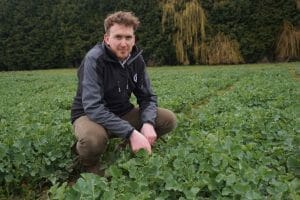 “LG Armada is the first of our seventh generation of hybrids, bringing new maintainer and restorer lines to our OSR portfolio. This effectively means we are bringing varieties to market offering a stacked portfolio of much improved stem health attributes, alongside the standard pod shatter, TuYV and RLM7 resistance traits.”
“LG Armada is the first of our seventh generation of hybrids, bringing new maintainer and restorer lines to our OSR portfolio. This effectively means we are bringing varieties to market offering a stacked portfolio of much improved stem health attributes, alongside the standard pod shatter, TuYV and RLM7 resistance traits.”
“We know stem health is key to driving consistent oilseed rape yields across farms and with these seventh-generation hybrids, we are seeing bigger stems and better rooting which also results in higher oil content,” he says.
Highest yielding maize
Limagrain’s maize variety, Saxon was added to the BSPB 2023 Forage Maize Descriptive List and has made the top of the list for 2024 for its ME yield of 225 (‘000s MJ/ha). It has dry matter yields of 19.1 t/ha, making it ideal for all uses, including anaerobic digestion.

“On the Descriptive List, Saxon yields 105% of the average and additionally is quite an early variety with an FAO of 180,” says Tim Richmond, Limagrain’s product manager for maize.
“Saxon combines superb early vigour with good standing power, making it perfectly suited for all mainstream maize sites.”
“LGAN has long been the watchword for maize varieties that deliver what really counts – high yields of high-quality feeds that sustain excellent milk yields. Saxon is one of the latest examples of the benefit of breeding varieties that deliver in the clamp.”
To learn more about how any of these varieties could perform on your farm, click the links below;
LG Maize
LG Winter Wheat
LG Winter Barley
LG OSR
- * Data: 2024/25 AHDB RL / *2-row winter barley. 2024 BSPB NIAB Forage Maize Descriptive List – First choice varieties for favourable sites by ME yield of fresh plant at harvest (‘000s MJ/ha)
A large estate in the North east of England, has turned to wheat variety LG Typhoon as part of its drive to build a more sustainable regenerative cropping system.
The in-house farming operation of County Durham-based Raby Estates began conversion to direct drilling in 2018 and is striving to reduce the use of artificial inputs where possible, without compromising on the quality and quantity of crops produced.
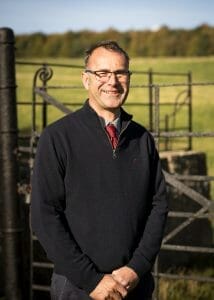
Philip Vickers
It is a challenge that the variety lived up to last season, according to farm manager Philip Vickers, who decided to trial the variety on the recommendation of Limagrain UK’s arable technical manager, Ron Granger.
“We’re trying to move away from growing high input varieties, so are primarily looking for those that offer a robust disease package, good standing power and suitability for our direct drilling system,” Mr Vickers says.
“Direct drilling in northern England is not something you want to be doing into November, so I also look for varieties that suit the early drilling slot. From what we’ve seen so far, LG Typhoon seems to fit our requirements well.”
Strong performance
Last season the farm grew around 32 ha (80 acres) of LG Typhoon, alongside several other varieties, but Mr Vickers has been so impressed with its agronomics, ease of management and yield performance, that he plans to increase this to 100 ha for 2023/24.
The LG Typhoon averaged an excellent 9.4-9.6 t/ha. A number of weather-related challenges throughout the season however, including exceptionally high Septoria pressure, did not make for an easy growing season.
The LG Typhoon was direct drilled in mid-September as a first wheat after oilseed rape, using the farm’s 6-metre Horsch Avatar, or 6-metre Väderstad Seed Hawk, drills. Seed rates were kept relatively high at around 300/m2, to counter the slightly lower establishment percentage experienced when direct drilling.
All crops received a base application of phosphate and potash fertiliser, plus a total of up to 170 kg N/ha in the spring, applied as three splits; the first as granular urea, followed by two liquid nitrogen applications.
“We have been reducing nitrogen use significantly in recent years, but in contrast to conventional thinking, some crop yields have gone up in that period,” Mr Vickers notes.
“Agronomy-wise, LG Typhoon was problem-free,” he continues. “It established quickly in the autumn, got away well in the spring, and was relatively early to harvest, tight behind Graham.”
But even though it established quickly, he says LG Typhoon did not get too large, unlike some other varieties, which continued tillering throughout a very mild autumn, during which temperatures hit 21°C in November. Those varieties then became much harder to manage with growth regulators and fungicides in the spring.
Robust disease profile
Strong Septoria resistance is a must-have for all winter wheat varieties grown on the farm, as the disease remains the number one yield-robber in high pressure seasons such as 2023, Mr Vickers says. “We generally look for varieties with a Recommended List score of at least six.”
With a Septoria rating of 7.3, backed up by a combination of genetics that are different to those in other RL varieties, giving LG Typhoon a distinct advantage over other varieties.
Although crops received the farm standard fungicide programme, based around Iodus (laminarin) at T0, bixafen/prothioconazole at T1, Univoq (fenpicoxamid + prothioconazole) at T2, and straight tebuconazole at T3, he was able to reduce rates by 10-15% on the LG Typhoon due to its robust disease profile.
“To ease management, we generally try to keep fungicide products similar across all varieties, but will look to vary the rate where appropriate.
“Despite doing so on the LG Typhoon, we still didn’t see any disease of significance at all last season, even though there was very high Septoria pressure which caused some other varieties to struggle.”
Accurate spray timing is also key to maintaining effective disease control, as is a robust trace element programme to bolster plant health and reduce the crop’s susceptibility to disease infection, he adds.
Perfect fit for regen systems
Mr Granger says LG Typhoon has certain attributes that make it ideally suited to strip tillage/direct drilling, regenerative crop establishment systems, that often feature wider rows.
LG Typhoon’s growth habit, for example, means plants sit prostrate with slower growth through the winter into spring, which is ideal for those direct drilling earlier in the autumn and who do not want a variety that races off too quickly.
It is a high tillering variety that has the capacity to utilise the space between the wider rows, often found with some direct drilling equipment.
Indeed, while Mr Vickers’s Horsch drill works on a standard row spacing, the Väderstad is at a slightly wider 180-200 mm spacing, and he also trialed a new 12-metre tine drill last season, which worked on a wider 250 mm row width.
“Unfortunately, we don’t yet have the yield data available, as the demo field was combined by a contractor, but the LG Typhoon did seem to really suit that wider row spacing. It’s something we may potentially look at in the future, although I’m not sure a 12-metre machine is suited to some of the smaller fields on our farm.”
Another attribute of LG Typhoon that makes it a good fit for regenerative systems, and for those looking for flexibility with crop protection inputs, is its strong standing power and disease resistance – reflected by its high untreated yield (92%), Mr Granger says.
Unlike some other feed varieties, it also offers Orange Wheat Blossom Midge (OWBM) resistance, in addition to a six-rating for eyespot and Fusarium.
“It’s a high yielding, consistent and resilient variety, that delivers across seasons and rotations.”
Raby Farms
- In-house farming division of Raby Estates (Shropshire and County Durham)
- The Durham farm typically grows 500-600 ha of winter wheat, mainly hard Group 4 feed
- Cropping also includes winter barley, oilseed rape and beans
- Started conversion to direct drilling in 2018
- Looking to develop a more regenerative system, reducing reliance on artificial inputs
- Started growing LG Typhoon in 2022/23
- High yielding hard Group 4 feed wheat
- Consistent performance across different seasons and regions
- Excellent disease resistance, especially Septoria (7.3) and yellow rust (9) – high untreated yield (92%)
- OWBM resistance
- Growth habit suits early drilling and wider row regenerative systems
- Excellent performance as a second wheat
Quality wheat breeding is losing a renowned figure as Ian Foot retires from the world of flour functionality and baking at leading plant breeders Limagrain UK, where he has headed up the quality wheat programme for the last 30 years.
 Whilst Ian Foot’s retirement marks the end of an era, it also marks the beginning of a new chapter, led by a passionate and skilled successor. As the torch is passed on to Ewa Lagowska, the spirit of innovation and excellence in wheat quality breeding continues to thrive at Limagrain UK.
Whilst Ian Foot’s retirement marks the end of an era, it also marks the beginning of a new chapter, led by a passionate and skilled successor. As the torch is passed on to Ewa Lagowska, the spirit of innovation and excellence in wheat quality breeding continues to thrive at Limagrain UK.
Ian had an unconventional start to his journey in science. He didn’t like his history teacher at school, so he opted to take biology instead!
 This led him to pursue biology at higher education, firstly at the Northeast Surrey College of Technology and subsequently at the West of Scotland Agricultural College, where Ian’s six-month industrial placement turned into a transformative few years at Throws Farm.
This led him to pursue biology at higher education, firstly at the Northeast Surrey College of Technology and subsequently at the West of Scotland Agricultural College, where Ian’s six-month industrial placement turned into a transformative few years at Throws Farm.
During this time, Ian not only gained valuable practical knowledge but also discovered his true calling. He returned to his studies with newfound zeal and completed a degree in agriculture, specialising in Crop Production. Armed with his newly acquired knowledge, he landed a position at Twyford Seeds, where he managed seed quality and pathology labs.
 However, it was all change in the early 1990’s, when he found himself working for plant breeders Nickerson, who at that time had recently been acquired by Limagrain. Here he had the privilege of working under the mentorship of the esteemed wheat breeder, Bill Angus. Under Bill’s guidance, Ian honed his skills and became deeply involved in quality wheat breeding.
However, it was all change in the early 1990’s, when he found himself working for plant breeders Nickerson, who at that time had recently been acquired by Limagrain. Here he had the privilege of working under the mentorship of the esteemed wheat breeder, Bill Angus. Under Bill’s guidance, Ian honed his skills and became deeply involved in quality wheat breeding.
Ian took on the role of quality wheat manager, where he played a crucial role in developing quality programs that bridged the gap between end-user requirements and wheat breeding for the bread and biscuit sectors.
Working closely with wheat breeder Ron Granger, Ian spearheaded the development of the leading milling variety, Crusoe. Collaborating with the baker, Warburtons, Ian and his team had set out to find a wheat variety that could potentially replace the popular variety, Hereward. This variety had to meet Warburtons’ stringent quality requirements, including the quality of the flour, its functionality, baking performance and colour. For a variety to make a Group 1, it needs to deliver all this consistently.
The creation of Crusoe was a triumph. It not only met Warburtons’ high standards but also proved to be a resounding success in the market.
Today, more than a decade later, Crusoe remains one of the leading quality wheats, a testament to Ian’s visionary work and it has just been awarded the NIAB Variety Cup. 
Ian Foot remains modest about his achievements and acknowledges the challenges of quality wheat breeding. The complexity of the task, with numerous independent variables to consider, makes it rare for a variety to tick all the boxes and endure in the competitive market.
Nevertheless, Ian’s passion for science, dedication to his craft, and commitment to improving agriculture have left a lasting impact on the industry and earned him a well-deserved place among the pioneers of quality wheat breeding.
LG Skyscraper is perfect fit for Fife growersConsistent yield performance over several seasons, strong agronomics and suitability for later drilling, have seen soft wheat LG Skyscraper become a mainstay of the rotation for two Fife growers.
Tenant farmer and contractor, Zander Hughes, who farms 320 ha (800 acres) of combinable crops for a range of clients, has been growing the variety for several years, and has 81 ha in the ground for this harvest – his whole winter wheat area.
“We saw LG Skyscraper in trials a few years ago and liked the look of it. It fits our main markets, as we grow predominantly soft wheats that tend to go for distilling at the local Cameronbridge distillery in Leven.”
But, it is LG Skyscraper’s strong yield performance across multiple seasons, drilling dates, and rotational positions, that he most values, with yields averaging more than 10 t/ha over multiple seasons, and up to 13.5 t/ha at best.
“Yield is king for us. We’re always looking to achieve the biggest end margin, and that usually coincides with the highest yield. Importantly, our average is based on marketable yield, which is the actual weight sold to the end user, not just what the combine yield monitor says.”
Grain quality has been consistently good too, with protein typically averaging 10.5-11%. While this is not crucial to him from an end market point of view, especially as there are many local animal feed outlets should crops not go into distilling, protein content does provide a useful indicator of nitrogen use efficiency, he says.
“Specific weight is a priority though, and all wheats have performed very well in recent years.”
Good straw yield is an added benefit, given strong demand from livestock producers in the area, he notes.
Late drilling suitability
Most of Mr Hughes’s LG Skyscraper is sown as a first wheat after either potatoes, vegetables (broccoli/ cauliflower), grass or spring barley, so he appreciates the variety’s flexibility for medium to later drilling.
“Around 60% of land is still ploughed, with the remainder established on a min-till system. We typically drill wheat in the third week of September, but have drilled anywhere from 20 August to 20 January.
“This year we’ve got LG Skyscraper that didn’t go in until the first week of December and still looks exceptional. The crop’s all standing, looks strong, and clean. It’s what you want a wheat to look like.”
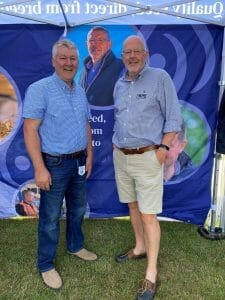
Russell & Nickerson’s Douglas Bonn
Mr Hughes says LG Skyscraper has a fairly vigorous growth habit once it germinates, so he has no fear of sowing it later, as he might with some other varieties. “In general, it is pretty flexible, although is probably not particularly suited to early drilling.”
Fellow Fife grower, Russell Black, near Cupar, also values LG Skyscraper’s suitability for later drilling. This year, he is growing around 20 ha of LG Skyscraper, plus 20 ha of LG Spotlight, with all LG Skyscraper sown as a first wheat after potatoes on good quality loam soils.
“We usually don’t start drilling wheat after potatoes until the end of October, so tend to work with quite high seed rates to ensure there are sufficient tillers. At the end of October, when conditions are cooler, days are shorter and the ground is wetter, we might be sowing 500 seeds/m2, whereas in September we’d be down at 350-400 seeds/m2.”
Most land is ploughed before drilling, with compound phosphate and potash fertiliser applied with seed and three equal splits of nitrogen, plus sulphur in the spring.
“We’re looking for a target yield of at least 10 t/ha, and that’s what we’re consistently achieving,” Mr Black continues. “This is our fourth year of growing LG Skyscraper and it’s been a very consistent variety, in terms of yield and disease.”
Easy to manage
Both farmers believe LG Skyscraper is a fairly straightforward variety to grow, with strong agronomics.
Despite being slightly taller-strawed, lodging has never been an issue for either grower, and no major disease issues have been seen.
Mr Hughes typically employs a four-spray programme, T0 to T3, with robust rates of good chemistry, and tight spray intervals.
LG Skyscraper’s resistance to Septoria and yellow rust was put to the test this season, when wet weather in February and March meant the T0 could not be applied to any of Mr Hughes’s wheat, and crops faced relatively high disease pressure.
“Normally, we’d also have applied a growth regulator with the T0, so despite missing one growth regulator and one fungicide, it still looks exceptionally good at the moment. We’re getting on really well with it.”
Mr Black describes LG Skyscraper as an excellent “farmer-friendly variety that’s not challenging to grow and is easy to manage”. “It really suits our farm and what we’re trying to achieve.”
He recognises that with the farm being within a Nitrate Vulnerable Zone (NVZ), which limits nitrogen applications, and most LG Skyscraper sown late, yields might be slightly restricted, so he is keen to see how the variety will perform when sown earlier.
“We are looking to go back into oilseed rape this autumn, after not growing it for a few years due to clubroot problems. This will give us the chance next year to sow LG Skyscraper in September, which I’m really looking forward to. There might be a better variety for the earlier-sowing slot, but if not, then it will be LG Skyscraper.
“I want to focus on growing first wheats as our land is too light to support a decent second wheat. With the cost of inputs, you can’t afford to have an 8 t/ha crop anymore; it doesn’t stack up.”
Like Mr Hughes, Mr Black says LG Skyscraper has always been a fairly clean variety, with his crops also getting a four-spray programme, which this year included Revystar XE (fluxapyroxad + Mefentrifluconazole) at T1 and Univoq (Fenpicoxamid + prothioconazole) at T2. Fungicides are generally applied at half-rate to keep costs down, he notes.
Most of Mr Black’s LG Skyscraper also goes into the Cameronbridge distillery, although in the past he has managed to sell some for biscuit-making, gaining a slight premium over the feed price. Quality-wise, it performs consistently well, with specific weight often hitting 80 kg/hl, resulting in a nice bold grain sample, he adds.
“It’s a consistent variety all-round. I like it, so plan to grow it again after potatoes this year, then we’ll see how it does after oilseed rape next year.”
Mr Hughes acknowledges he is always looking at other varieties, to see what is best for the farm business, but currently has no plans to change. “At the moment, I think 80-90% of our 2023/24 acreage will be LG Skyscraper again. Until I see a reason to change to something better, or LG Skyscraper lets us down, then we will continue growing it.”
































